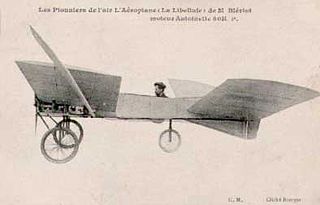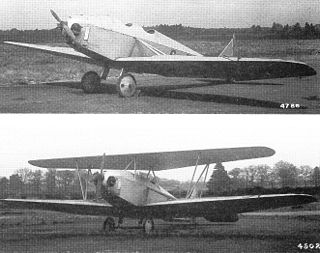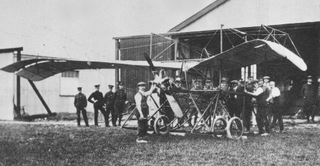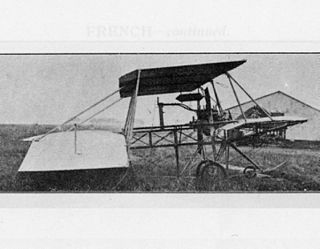Related Research Articles

The Rutan Quickie is a lightweight single-seat taildragger aircraft of composite construction, configured with tandem wings.

The Blériot V was an early French aircraft built by Louis Blériot in 1907 and was his first monoplane. Although Blériot only achieved a couple of short flights in it, the second resulting in a crash which damaged the aircraft beyond repair, it was the first of his experimental aircraft to achieve any measure of success.

The Blériot VI "Libellule" ("Dragonfly"), was built in 1907 and was one of the series of experimental aircraft built by Louis Blériot which eventually led to the Blériot XI aircraft in which he made the first flight across the English Channel.

The Bréguet Type I was an experimental aircraft built in France in 1909. It was Louis Bréguet's first fixed-wing aircraft design. Bréguet had previously had some success with two helicopter designs, one of which had been exhibited at the Paris Aero Salon in December 1908. Because of these machines, the Type I was at first known as the Bréguet Type III.

The Bristol B.R.7 was a Romanian-designed single-engine two-seat biplane built by Bristol to a Spanish government order in 1913. It failed to meet its specifications and the order was cancelled.

The Parnall Pixie was a low powered British single-seat monoplane light aircraft originally designed to compete in the Lympne, UK trials for motor-gliders in 1923, where it was flown successfully by Norman Macmillan. It had two sets of wings, one for cross-country flights and the other for speed; it later appeared as a biplane which could be converted into a monoplane.

The Pfitzner Flyer was an innovative monoplane designed in 1909 by Alexander Pfitzner and built by the Curtiss company at Hammondsport, NY, where Pfitzner was employed at the time.

The Dunne D.7 was one of J. W. Dunne's swept wing tailless aircraft designed to have automatic stability, first flying in 1911. It was a single seat, single engined pusher monoplane developed from the unsuccessful D.6.

The Farman FF 65 Sport was a French built light biplane, with a single engine and tandem seats, intended for sport and touring. First flown in 1919, it achieved modest sales at home and abroad in the early 1920s. Two unusual modifications produced a biplane glider and a low aspect ratio parasol wing machine.
The Peyret Tandem or Peyret Alérion, was a French single seat glider of tandem wing configuration. It won first prize at the first British Glider Competition of 1922.

The ASL Viking was a single-engined two seater biplane aircraft designed and built by Horatio Barber's Aeronautical Syndicate Ltd. at Hendon. It was first flown in January 1912.
The Czerwiński Sparrow, sometimes known as the de Havilland Canada glider, was a single seat glider, designed and built by a group of de Haviiland engineers in Canada in 1942. It was intended to popularise gliding and be suitable for both basic training and thermal soaring.

The Martinsyde Semiquaver was a British single-seat racing biplane built by Martinsyde in 1920. It won the 1920 Aerial Derby and was entered for the 1920 Gordon Bennett Trophy, but did not finish the course. In 1921 the fuselage was used as the basis for the Alula Monoplane, an experimental aircraft intended to investigate the performance of a radical wing design by A. A Holle.

The Hanriot 1909 monoplane was an early French aircraft constructed by Rene Hanriot, a successful automobile racer.
The Star Monoplane was an early British aircraft built by the Star Engineering Company of Wolverhampton. A tractor configuration monoplane resembling the French Antoinette aircraft, its most remarkable feature was the arrangement of the rear control surfaces. It was exhibited at the Aero Exhibition at Olympia in London, in 1910.

The Caudron Type A was the first successful aircraft built by René Caudron and his brother Gaston. During 1910 the Caudron brothers were briefly associated with the Société Anonyme Français d'Avaiation (S.A.F.A.), and an example of the type was exhibited at the 1910 Paris Aero Salon as the S.A.F.A. Biplane.

The 1910 Deperdussin monoplane was the first aircraft to be built in significant quantities by Aéroplanes Deperdussin. The type was produced in a number of variants which were flown successfully in air races and gained several records during 1911, and was used by the Australian Central Flying School at Point Cook, Victoria. Several have survived, including an airworthy example in the Shuttleworth Collection in England.

The Caproni Ca.95 was a large, three engine, long range, heavy bomber prototype built in Italy in 1929. It could carry a 1,600 kg (3,500 lb) bomb load and had three defensive gun positions. Only one was built.

The Dunne-Huntington triplane, sometimes referred to as a biplane, was a pioneer aircraft designed by J. W. Dunne and built by A. K. Huntington. It was of unusual staggered triple-tandem configuration and an early example of an inherently stable aeroplane.
The Caproni Ca.61 was an Italian heavy day bomber aircraft of 1922. It was the final development of the Caproni three engine, twin boom biplane types developed during World War I, but it was not put into production.
References
- Lewis, Peter. British Aircraft 1809-1914. London: Putnam 1962